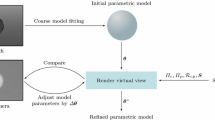Abstract
In recent years, various methodologies of shape reconstruction have been proposed with the aim at creating Computer-Aided Design models by digitising physical objects using optical sensors. Generally, the acquisition of 3D geometrical data includes crucial tasks, such as planning scanning strategies and aligning different point clouds by multiple view approaches, which differ for user’s interaction and hardware cost. This paper describes a methodology to automatically measure three-dimensional coordinates of fiducial markers to be used as references to align point clouds obtained by an active stereo vision system based on structured light projection. Intensity-based algorithms and stereo vision principles are combined to detect passive fiducial markers localised in a scene. 3D markers are uniquely recognised on the basis of geometrical similarities. The correlation between fiducial markers and point clouds allows the digital creation of complete object surfaces. The technology has been validated by experimental tests based on nominal benchmarks and reconstructions of target objects with complex shapes.
Similar content being viewed by others
References
Varady T., Martin R.R., Cox J.: Reverse engineering of geometric models—an introduction. Comput. Aided Des. 29(4), 225–268 (1997)
Gorthi S.S., Rastogi P.: Fringe projection techniques: whither we are?. Opt. Lasers Eng. 48(2), 133–140 (2010)
Hartley R., Zisserman A.: Multiple View Geometry in Computer Vision. Cambridge University Press, Cambridge (2000)
Bernardini F., Rushmeier H.: The 3D model acquisition pipeline. Comput. Graph. 21(2), 149–172 (2002)
Besl P.J., McKay N.D.: A method for registration of 3D shapes. IEEE Trans. Pattern Anal. Mach. Intell. 14(2), 239–256 (1992)
Barone, S., Curcio, A., Razionale, A.V.: A structured light stereo system for reverse engineering applications. In: XIII ADM—XV INGEGRAF, Cassino, Italy (2003)
Callieri, M., Fasano, A., Impoco, G., Cignoni, P., Scopigno, R., Parrini, G., Biagini, G.: RoboScan: an automatic system for accurate and unattended 3D scanning. In: 3DPVT’04, pp. 805–812, Thessaloniki, Greece (2004)
Sansoni, G., Patrioli, A.: Non contact 3D sensing of free-form complex surfaces. In: Proceedings of SPIE Videometrics and Optical Methods for 3D Shape Measurement, vol. 4309, pp. 232–239 (2000)
Gelfand, N., Mitra, N.J., Guibas, L.J., Pottmann, H.: Robust global registration. In: Proceedings of the Third Symposium on Geometry Processing, pp. 197–206 (2005)
Huber D.F., Hebert M.: Fully automatic registration of multiple 3D data sets. Image Vis. Comput. 21(7), 637–650 (2003)
Li N., Cheng P., Sutton M.A., McNeill S.R.: Three-dimensional point cloud registration by matching surface features with relaxation labeling method. Exp. Mech. 45(1), 71–82 (2005)
Beinat, A., Crosilla, F., Sepic, F.: Automatic morphological pre-alignment and global hybrid registration of LiDAR close range images. In: ISPRS Symposium on Image Engineering and Vision Metrology, Dresden, Germany (2006)
Rugis, J., Klette, R.: Surface registration markers from range scan data. In: 11th International Workshop on Combinatorial Image Analysis (IWCIA), pp. 430–444 (2006)
Pingi P., Fasano A., Cignoni P., Montani C., Scopigno R.: Exploiting the scanning sequence for automatic registration of large sets of range maps. Comput. Graph. Forum 24(3), 517–526 (2005)
Rekimoto, J., Ayatsuka, Y.: CyberCode: designing augmented reality environments with visual tags. In: DARE on Designing Augmented Reality Environments, vol. 1, pp. 1–10 (2000)
Fiala M.: Designing highly reliable fiducial markers. IEEE Trans. Pattern Anal. Mach. Intell. 32(7), 1317–1324 (2010)
Ababsa F., Mallem M.: A robust circular fiducial detection technique and real-time 3D camera tracking. J. Multimedia 3(4), 34–41 (2008)
Naimark, L., Foxlin, E.: Circular data matrix fiducial system and robust image processing for a wearable vision-inertial self-tracker. In: IEEE International Symposium on Mixed and Augmented Reality (ISMAR 2002), vol. 1, pp. 27–36 (2002)
Nakazato, Y., Kanbara, M., Yokoya, N.: Localization of wearable users using invisible retro-reflective markers and an IR camera. In: SPIE, vol. 5664, pp. 563–570 (2005)
Claus, D., Fitzgibbon, A.W.: Reliable fiducial detection in natural scenes. In: 8th European Conference on Computer Vision (ECCV ‘04), vol. 4, pp. 469–480 (2004)
Galantucci L.M., Percoco G., Dal Maso U.: Coded targets and hybrid grids for photogrammetric 3D digitisation of human faces. Virtual Phys. Prototyp. 3(3), 167–176 (2008)
Bowyer K.W., Chang K., Flynn P.: A survey of approaches and challenges in 3D and multi-modal 3D+2D face recognition. Comput. Vis. Image Und. 101(1), 1–15 (2006)
Audette M.A., Ferrie F.P., Peters T.M.: An algorithmic overview of surface registration techniques for medical imaging. Med. Image Anal. 4(3), 201–217 (2000)
Wyawahare M.V., Patil P.M., Abhyankar H.K.: Image Registration Techniques: An Overview. Int. J. Signal Process. Image Process. Pattern Recognit. 2(3), 11–28 (2009)
Fiala M., Shu C.: Self-identifying patterns for plane-based camera calibration. Mach. Vis. Appl. 19, 209–216 (2008)
Owen, C., Xiao, F., Middlin, P.: What is the best fiducial? In: 1th IEEE International Augmented Reality Toolkit Workshop, Darmstadt, Germany (2002)
Creaform.: http://www.creaform3d.com. Accessed 25 June 2010
GOM mbH.: Optical measuring techniques. http://www.gom.com. Accessed 25 June 2010
Tsai R.Y.: A versatile camera calibration technique for high-accuracy 3D machine vision metrology using off-the-shelf TV cameras and lenses. IEEE J. Robot. Autom. RA-3(4), 323–344 (1987)
Barone, S., Razionale, A.V.: A reverse engineering methodology to capture complex shapes. In: XVI INGEGRAF, Zaragoza, Spain (2004)
Soille P.: Morphological Image Analysis: Principles and Applications. Springer, Secaucus (2003)
Vincent L.: Morphological grayscale reconstruction in image analysis: applications and efficient algorithms. IEEE Trans. Image Process. 2(2), 176–201 (1993)
Otsu N.: A threshold selection method from gray level histograms. IEEE Trans. Syst. Man Cybern. 9, 62–66 (1979)
Harris, C., Stephens, M.: A combined corner and edge detector. In: Proceedings of the Fourth Alvey Vision Conference, pp. 147–151 (1988)
Fusiello A., Trucco E., Verri A.: A compact algorithm for rectification of stereo pairs. Mach. Vis. Appl. 12(1), 16–22 (2000)
Eggert D.W., Lorusso A., Fisher R.B.: Estimating 3-D rigid body transformations: a comparison of four major algorithms. Mach. Vis. Appl. 9, 272–290 (1997)
Author information
Authors and Affiliations
Corresponding author
Rights and permissions
About this article
Cite this article
Barone, S., Paoli, A. & Razionale, A.V. Three-dimensional point cloud alignment detecting fiducial markers by structured light stereo imaging. Machine Vision and Applications 23, 217–229 (2012). https://doi.org/10.1007/s00138-011-0340-1
Received:
Revised:
Accepted:
Published:
Issue Date:
DOI: https://doi.org/10.1007/s00138-011-0340-1




